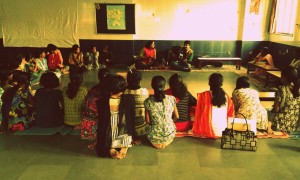
#1 : Crisis knows no Clock
Megha Gupta
Project Coordinator
It was around 6:30 in the evening when I finished work. The second week of August 2018 was also my second week at Prerana. I was still getting used to being on-field for the whole day. I was at the platform waiting for the train to arrive, when I saw my colleague’s name flash on the incoming call. The train was not expected for another two minutes, and I figured I could quickly tell her that I will call later. Little did I know that I would not be getting onto the train at all, after taking that call.
Aaheli told me that Sonali (name changed to protect the identity of the child), the child we had just spoken to at the Children’s Home, had consumed poison in an attempt to take her life. The staff at the Home wanted us to come back as we were the last people who the child had spoken with. Sonali was 16 when she had been rescued from the sex trade. She had been trafficked by someone in her neighborhood. Prerana was following-up on the case and was assisting the child through the process of rehabilitation. This is done by assessing the needs of the child through regular interactions and then delivering those needs through a structured rehabilitation plan.
Sonali was supposed to be transferred from the her current child care institution new facility for her rehabilitation and she had been really looking forward to it. The staff of the Home had also spoken highly of the facility, making the child more excited for the new journey. However, due to certain issues of jurisdiction, the transfer could not materialize. Before leaving the Home that evening, we had informed Sonali of the change in plans and the cancellation of her transfer. We had to tell her that the Home where she wanted to be transferred to fell under the jurisdiction of a different district, and thus the transfer could not happen. She had not taken the news well and seemed upset at the thought of continuing to stay in the current Home. Personally, I could not believe that a child could attempt to end her own life for such a reason but things are never as simple as they look, is what I would learn later in the course of my work in child rights.
My colleague and I reached the Home to find a situation of panic. Sonali was refusing to go to the hospital and repeatedly kept muttering that she should be left alone. The caregivers in the Home were frantic, as both the Probation Officer and the Superintendent of the Home were not present. At that moment, we not only had to convince Sonali to go to the hospital but also pacify the other girls in the Home to create a situation that resembled normalcy. I tried to make Sonali understand why going to the hospital was necessary, while simultaneously trying to contact the local emergency helpline to request an ambulance. I was told that the ambulance was on its way. All that was left now, was to persuade Sonali to go to the hospital.
The Home staff had only two caregivers present, and one of them had to stay back to look after the other girls in the institution so we agreed to accompany the child to the hospital. I don’t think I will ever forget that ride to the hospital. I distinctly remember seeing Sonali lying down, while my colleague was talking to her, telling her that she will be okay. I could not help but run through the events of the day in my head, trying to figure out where we went wrong, or if there was anything we could have done differently.
Soon, we reached the hospital. Not knowing much about the functioning of government hospitals, I did not know what to do. When I look back to that incident now, i still cannot believe how we managed to mitigate that crisis. From waiting for the allotment of a bed, to speaking to the doctors and filling out the forms, we handled the urgency of the situation. Even during the crisis, I was sure of one thing, Sonali’s right to privacy should not be infringed upon. We ensured that the name of the Home or the term ‘rescue’, ‘sex trafficking’ was never mentioned. Sonali was asked to spend the night under observation but we were told that she is out of danger.
At the time, there was so much to be done that I did not have time to be left alone with my thoughts. In retrospect, I think that is how I could pull through. My mind did not let me focus on the gravity of the situation or how I felt about it, but instead, I was focused on accomplishing the next task at hand. I remember leaving the hospital hours later, once Sonali had fallen asleep from the medication.
Once back in office, I discussed the case and my thoughts on it with my seniors at work. Through the discussion, I learnt the importance of emotional detachment. While working with children directly on the field, emotional engagement is crucial, but not to the point of emotional exhaustion. The lack of former can alienate the social worker from the child, whereas the latter is often associated with professional burnout. Maintaining the right balance between healthy detachment and sincere empathy can be challenging, but I learned that with time and experience, it becomes possible.
It was much later that I became aware of the real reason why Sonali had taken such a drastic step. The girls in the Children’s Home would make insinuations about Sonali’s friendship with another girl, by taunting her about her sexual orientation. Sonali did not like their behaviour and hence, was eager to move out of the Home at the earliest. To this day, I shudder at the thought of a child trying to end her own life because of how she was being treated by her peers.
Sonali’s behaviour also seemed to indicate a fear of abandonment. She had difficulty in understanding why her mother preferred for her to stay in a shelter facility, instead of wanting her to come home. Sonali’s safety was a crucial reason for her having to live in the facility. The accused in the case was out on bail, and she had been threatening Sonali’s mother to withdraw the case. These instances pointed towards Sonali being at risk in her neighbourhood. However, considering the trauma she had undergone, she could only focus on being devoid of her mother’s affection. For the child, it was just a series of incidents where she felt unwanted – when her mother ‘refused’ to have Sonali back in their house, when the other children in the Home did not understand her feelings, when she was made to feel unwelcome in the Home, and finally, when she was turned down from being transferred to the new Home. In retrospect, I believe a culmination of these feelings might have also influenced her to take the step of ending her life.
It was a day that made me feel many things. I felt responsible. I felt responsible for the incident and also felt that I was responsible for ensuring that Sonali receives the best medical care. It was also a day that taught me a lot. It taught me how one should be careful of the promises made to children. It taught me how to remain calm in the face of a crisis. It was a day that put me in a difficult situation, and then made me learn how to deal with it. It was a day that made me realize how some children do not value their life because they haven’t been taught to value themselves. It made me hope for a day that every child would understand the importance of their life, personality, and identity without being affected by the thought of what people will say. It is not something that can be achieved in one day. It is a series of interventions that will restore their dignity by protecting their rights and creating better choices. But one day, I know that it will come true. And I wait for that one day to be here.
To be or not to be? Questions on motherhood searching answers
The blog post was first published on Dr. Pravin Patkar's Blog 'Expressions'. The post sheds light on the impact and Read more
Trauma cannot be addressed as a standalone problem. It needs to be addressed holistically, keeping in mind various experiences and Read more



